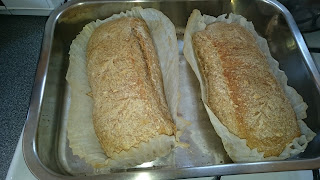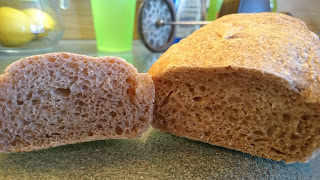Well, not really, but it was time I blogged about bread…
Pretty isn't it? The waterways of Norfolk with the famous broads and their interconnecting rivers where I was on a family holiday last week. It allows the mind to concentrate, being on a cruiser with limited space to move around until you step ashore. We were well stocked with supplies of fine ale of course, and home-baked bread for the four days we could expect it to keep, but we were well aware that shopping opportunities for bread would be limited to the industrially produced Chorleywood version. I decided to set myself a challenge: on-board Realbread.
This is not to say “This is so easy that anyone could do it.”, nor “This is really difficult so aren't I clever?”; just the hope that somebody will try sourdough in September as a result of reading this because I enjoyed doing it. It's not the best way to go about what I did if you're planning it, but it worked. You can study all the details elsewhere about how 17° is the ideal temperature for a thriving sourdough and how bakers strive to keep their kitchens free from draughts. This is what can be done in the wild.
There was a gas cooker on board with an oven, but no prospect of buying breadflour or yeast for a few days. All we had on board was some self raising white flour. The challenge then was to make a loaf, starting by culturing the natural wild yeasts on blackberries into a sourdough. Here goes!
Day zero
This is the start, it's a couple of dessertspoonsful of white flour (let's gloss over the fact that self raising was all that I had available [shock-horror!]) made into a paste with water plus a handful of the ripest blackberries I could find, preferring those with just a slight bloom of the wild yeast visible on them.For the record, I used bottled mineral water because the chlorine in tap water is best avoided. Boiled tap water left to get cold would have done just as well. I kept a damp piece of kitchen paper precariously held on top by a loosely fitting lid because you need to let fresh air get to it, but not to let it dry out. So there it sat in its little coffee cup evidently quite happy with the wildly fluctuating temperature until…
Day three
Signs of life are definitely there because the mixture is bubbling with evidence of fermentation. It's time to strain off the blackberries — oh, that would have been easier with a tea-strainer, but never mind, I'll just use a fork, a spoon and care not to let any non-child-friendly language slip out as bits of blackberry try to sneak back in.40g. of starter reporting for duty –Sir!
Meanwhile some on-shore shopping had been done, so I now had actual bread flour: a kilo and a half of white plus a kilo of spelt. Also I could test the limits of the oven because I had some 7g. sachets of dried yeast. A test bake went well so my team of micro-organisms and I carry on.
Evening of day 3: 40g is doubled to 80.
We're now at the stage where, given an on average reasonable temperature, the culture is thriving. It doubles its quantity in 24 hours. Once a day it is fed with an equal quantity of flour and water, so this time I add 20g of water + 20g of flour to the 40 existing. I prefer the word leaven for what it is now. Sourdough is the type of bread made with it; leaven is the natural yeast itself, the word carrying with it all the nuances of centuries of antiquity. The interested reader can look up its significance in Biblical times: Moses prescribed in detail the occasions when unleavened as opposed to leavened bread was appropriate to eat. Equally interesting at the home end of history, scientists now know much of the detail of what happens at the molecular level. I just needed to let my six shipmates enjoy the holiday too while the beauty of it all continued.80 → 160 grams
At home, my regular practice is to double again on the next day (160 → 320), use 300g to make a couple of standard size loaves leaving 20 to start the doubling again. Here, I'm using 150g and letting the ten gram residuum live on after anther doubling, to come home with me in a tiny Kilner jar. (And to be named Herbert in honour of the company that owns the boat.)Flour, water, salt, leaven
Hang on a minute [intruder alarm!!!!] What is that object in the top centre of the picture? It's a cup of sugar photobombing the process of bread making. It must have snuck into shot because some of us have sugar in our tea/coffee and the workspace is crowded. That can be the only explanation because sugar is most definitely NOT a bread ingredient.What is sugar? [All together now]…
N O T … a … b r e a d … i n g r e d i e n t .
Thank you. [Smiley-face]
Mixed (the dessert spoon is sitting there as a size guide)
This looks like a good spot to list the quantities: basically it's half my regular sourdough makeup.375 g. breadflour (185g white + 190g spelt)
225 ml.water
160 g. leaven
10 g. salt
Mix & knead for 10 minutes.
All the books by all the Master Bakers will tell you precise times and temperatures to aim for. Afloat, I left it overnight at a damp 12°-ish.
Risen
In the early morning of day five, the fermented dough is ready to shape into loaves.Shaped ready for final rise
There's nothing fancy here. I decided to use silicone coated baking papers for the sheer ease of doing it and cleaning up afterwards. By early afternoon it was time to light the oven. Its control is marked in gas numbers, not something I'm not familiar with but the highest setting (9) should be about 240°. Oven up, and in it goes for thirty minutes.Baked
… and cut
A good sourdough justifies a robust crisp crust that comes from baking on a pre-heated stone. Obviously I couldn't get that, but the taste and feeling of satisfaction were great.Postscript
This was written in support of the Campaign for Real Bread (see @RealBread #Realbread) to whom I hereby grant the right to use any part of this article to promote their cause.
Details of Sourdough September can be found on their website http://www.sustainweb.org/realbread/
Thanks, as usual, to @DoughAnarchist for teaching me much of the fundamentals.












No comments:
Post a Comment